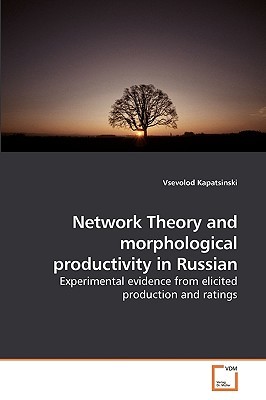
- We will send in 10–14 business days.
- Author: Vsevolod Kapatsinski
- Publisher: VDM Verlag
- ISBN-10: 3639208420
- ISBN-13: 9783639208429
- Format: 15.2 x 22.9 x 1.1 cm, minkšti viršeliai
- Language: English
- SAVE -10% with code: EXTRA
Network Theory and morphological productivity in Russian (e-book) (used book) | bookbook.eu
Reviews
Description
This book presents an implementation of Joan Bybee's Network Theory (1985, 2001) in a hybrid model involving representations of both individual tokens and word types, which accounts for effects of word and pattern frequency using the single mechanism of competition for spreading activation. Network Theory is tested against Steven Pinker and colleagues' Dual Mechanism Model using experimental data examining phonological factors influencing suffix choice with novel words adopted into Russian. Evidence for Network Theory over the Dual Mechanism Model is provided by the findings that all competing suffixes are sensitive to which words the novel word is similar to, with no suffix acting as a default. A dissociation between the defining characteristics of a Dual Mechanism default is reported. Evidence for exemplar representations (along the lines of Rens Bod's Data Oriented Parsing) is provided by the finding that suffix choice is conditioned by both the body and the rime of the stem, suggesting that constituents can exhibit partial overlap.
EXTRA 10 % discount with code: EXTRA
The promotion ends in 23d.03:33:53
The discount code is valid when purchasing from 10 €. Discounts do not stack.
- Author: Vsevolod Kapatsinski
- Publisher: VDM Verlag
- ISBN-10: 3639208420
- ISBN-13: 9783639208429
- Format: 15.2 x 22.9 x 1.1 cm, minkšti viršeliai
- Language: English English
This book presents an implementation of Joan Bybee's Network Theory (1985, 2001) in a hybrid model involving representations of both individual tokens and word types, which accounts for effects of word and pattern frequency using the single mechanism of competition for spreading activation. Network Theory is tested against Steven Pinker and colleagues' Dual Mechanism Model using experimental data examining phonological factors influencing suffix choice with novel words adopted into Russian. Evidence for Network Theory over the Dual Mechanism Model is provided by the findings that all competing suffixes are sensitive to which words the novel word is similar to, with no suffix acting as a default. A dissociation between the defining characteristics of a Dual Mechanism default is reported. Evidence for exemplar representations (along the lines of Rens Bod's Data Oriented Parsing) is provided by the finding that suffix choice is conditioned by both the body and the rime of the stem, suggesting that constituents can exhibit partial overlap.


Reviews